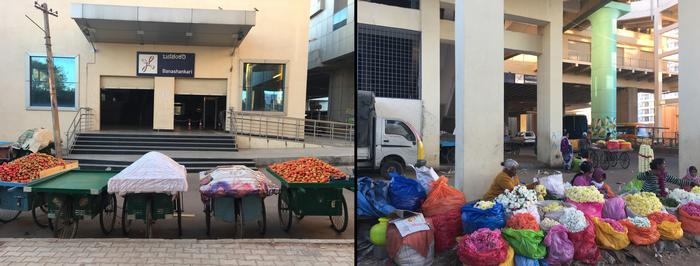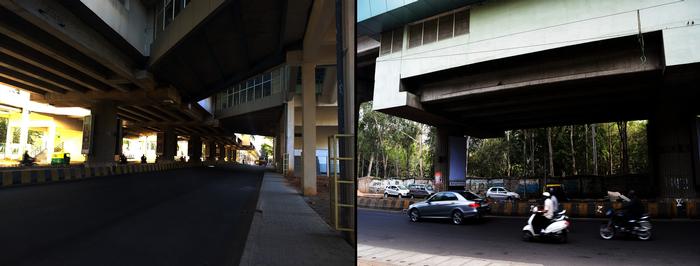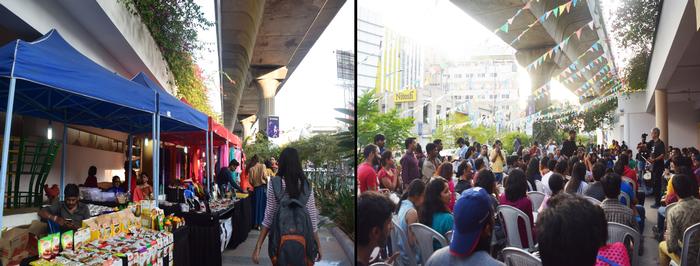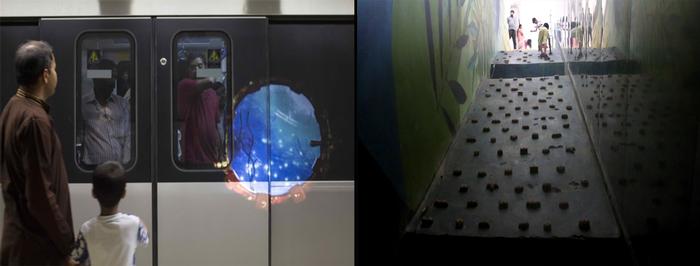[ID:2648] People, Place and Pace - The Social Significance of Public InfrastructureIndia In the words of Joseph Beuys, ‘A total work of art is only possible in the context of the whole society. Everyone will be a necessary co – creator of a social architecture, and, so long as anyone cannot participate, the ideal form of democracy has not been reached.’
The gulf between the rich and the poor is widening, threatening civilized values. Socially just cities are fundamental to tackling inequality. Mass transit is an element of infrastructure which inherently possess the power to affect the dynamics of a city. Whether or not this potential is recognized in the planning of these projects, the effects are felt after implementation. The metro stations in Bangalore are complicit in the displacement of communities on one hand, and are an effective public transportation system on the other. This paper is an inquiry aimed at understanding how the advent of mass transit can be utilized to serve the commuters and the neighborhood, making it an active participant in the life of the city. The paper highlights the possibilities for a city with a change in perception of the metro station by providing a variation of experiences at the station through the engagement of the local community.
Architects must articulate their designs to support the creation of ‘inclusive cities.' As Jane Jacobs said: “Cities have the capability of providing something for everybody, only because, and only when, they are created by everybody.” At different times of the day, each metro station creates unique dialogues with different levels of society. In order to fully understand the depth of these relationships, I documented my experiences at various stations in Bangalore.
Time: 7 am; Place: Basvangudi Metro station I’m cutting it close, rushing to catch my train. Just as I arrive in front of the station, I hear the vendor next to me scream: “Tomatoes! Only Rs.40! Grab them as you go!” Local fruit and vegetable sellers line the entrance to the station every morning. As I push through the crowd, I hear the sound of the train rolling down the line. I look up, it’s gone. Now I have fifteen long minutes before the next one arrives. My eyes scan the area. The space outside station has become active with pedestrians, meeting, moving and interacting. A police constable appears and begins to force the vendors out. The crowd diminishes and the massive concrete structure suddenly seems desolate. Without any presence of life, the visually unappealing and overwhelming nature of the overhead structure is immediately noticeable. I step over some squashed tomatoes and torn plastic bags as I ponder the missed opportunity at these stations. [Image. 1]
The transit stations should promote life, and in that capacity, they can be integral to the city, a part of the public space and street life. The station itself can be a microcosm of the city. In other words, because of its intense potential, a transit station should not be limited to a singular function. Commerce can be a part the station. The station can be an event, identifiable in the fabric of the city.
Time: 8 pm; Place: Kempegowda Metro Station, Bangalore After a long day at work, I’m standing in line to buy a ticket for the train. I tune in on what the girls behind me are saying. “I only use the metro when I have no other option”, says one of them. “I dislike standing in the huge crowds. I prefer taking a cab.” responds the other. In Bangalore, metro ridership is high but very few of those riders come from the city’s affluent classes. According to a survey conducted by the Bangalore Metro Rail Corporation Limited (BMRCL) last year, less than 2 percent of metro riders earn more than 100,000 rupees (about $1,540) a month. I’m holding down the urge to tell them that this aversion to public transportation by the rich is a detriment to society at large. “Can design help create a ‘transit culture’?" I ask aloud.
Transit structures, especially when designed as an elevated structure, have several meanings; a landmark or monument, a spatial framework or reference besides being an apparatus for transportation. A transit structure implemented in such a manner would move beyond its base purpose and would be a participating piece of the urban landscape rather than an intrusive object. By changing attitudes towards the design of transit architecture and imbuing such projects with an affirmative urban quality, these steel and concrete “monsters” can make a positive impact on the city. [Image. 2]
For architects in particular, the definition of what might constitute an architectural approach to infrastructure remains somewhat unresolved since the effects of infrastructure at the architectural scale are almost absent from contemporary discourse. The urban scale often focuses on the diminishing significance of form and boundaries — concrete architectural concepts — in the face of a system of networks and flows.
Nonetheless, the Rangoli Arts Center at the M.G. Road station is a notable attempt to enhance the community’s identity. It is a conscious decision to create public space for events that sporadically occur. The Center efficiently uses the dead space below the metro track. It is 30 meters wide and half a kilometer in length. A variety of activities which celebrate the city’s culture are placed along the stretch. The Nagara Pete (market place) is set up to support handmade art and craft products produced by the local community as they have no other structured space to sell their wares. The setting is ideal for independent artists, small collectives and cottage industries. The Center also includes a small auditorium which seats 120 people. It is available on hire to theater groups besides being used for sponsored shows. There are three art galleries, one measuring 120 x 20 feet, and two smaller galleries measuring 60 x 10 feet. Community music sessions and art demonstrations (such as woodcarving and batik painting) are regular events in the centrally located open space. The play area even includes play equipment for children with special needs. These flexible spaces which are open for expression, interpretation and participation bring together different people in the city who don’t normally interact. Programming in this context is not merely functional but also spatial and symbolic. It engages the city and all its citizens in a meaningful dialogue based on their needs and aspirations.
In a world where urbanization is increasingly produced by private capital, infrastructure appears as the backbone onto which these initiatives can be grafted. The goal is to create a better experience for the end user as well as provide a base for local commerce to make profitable investments. In order to achieve this, the transit activity must be linked in a manner that feeds directly into the commercial activity of the development. Thereby also creating revenue for station developers.
Time: 11am; Place: M.G. Road Metro Station, Bangalore I’m walking out the doors of the station and something catches my eye. Fluttering in the wind, a piece of red ribbon is stuck under a potted plant at the exit. The columns holding up the metro track are decorated with different colors of the same material. Drawn in by these embellishments, I walk down a few steps to the Rangoli Arts Center. The transition into this space is fluid and seamless in comparison to other stations which are severed from any pedestrian connect. People are coming and going, kids are running around and couples have seated themselves at the edge of low-height planter boxes that line the pathway. This space under the metro track is located at the leftmost end of a busy two way road. Planted trees provide a buffer to the traffic and create a pleasant micro climate. Today is different from other days at the Center. Several temporary stalls have been set up, selling everything from handmade jewelry to reusable cloth bags. I hear someone say that the theme for today’s market is ‘up-cycling.’ Some people have displayed their products on the customized plinths while others have set up their own tables. Clothes are also hung from staircase railings and on lines connecting one column to another. The dynamic nature of the space is exemplary. I cannot directly see what lies ahead. The curved walls create a sense of curiosity. At the same time, I’m visually captivated by the installation art showcased on these walls. The path eventually leads to the large green door of the art gallery.
Suddenly, I hear the sounds of drumbeats. It starts getting louder. I hear people begin to sing to the tune. I step out of the gallery, trying to follow the music to its source. Several temporary chairs have been set up in an open area. Adults and children alike are tapping their drums and singing along with a man who seems to be hosting the event. Even for just an on-looker, such community spirit is infectious. Someone sitting in a wheel chair is peering down at the performance. I didn’t notice the ramp running above all the activity spaces. The ramp extends from the metro station to the end of the Rangoli Arts Center, thus catering to the accessibility of the physically challenged. The ramp is also used by those who just want to get across and are not interested in these festivities. A two storied cafe serves pedestrians on both levels. [Image. 3]
There are several days in a week without such events taking place but the feeling of anticipation doesn’t cease to exist. The experience is disparate yet worthwhile. The presence of other engaging spaces brings the Center to life. 1. Narrative spaces, such as the information wall on how Bangalore city was formed or the ‘Letter to Gandhi’ initiative which encourages writing and the use of postal services. 2. Symbolic spaces, such as friendship point – where one can tie their friendship bands on the allocated wall. Such spaces allow people to reflect and create their own associations and personal connections with the space. 3. Representative spaces, such as the sculpture court and the display areas. These are passively experienced spaces where the interpretation is through the imagination of the viewer. 4. Leisure spaces, such as the interactive snakes and ladders board which is appealing to both the young and old. By creating an engaging program mix to draw people in, the center effectively uses the space under the metro track. For India, where the generation of new public spaces is difficult such citizen-driven interventions are of paramount importance.
An analogy, at a much smaller scale to this expanded interpretation of mass transit is the stairway. The vertical circulation within a single building can be approached in various manners. A stairway may be purely utilitarian, i.e. a fire stair where egress is the overriding concern or it can be a grand stairway of a mansion which serves as the heart of such a dwelling and provides much more than just a means of ascending or descending to another level. An even more extreme example is the Eiffel Tower. Despite its incredible size and scale, it makes an effort at ground level to have a relationship with pedestrians. This example may stretch the limits of what is considered infrastructure, but the Eiffel tower’s continuity and concern at all scales, making it as impressive up close as it is from a distance displays character that must be considered in the design of any public work. This expanded definition of infrastructure is nothing new. Elements laid out to supply basic services for communities have often played a larger role in the functioning of the settlement. It seems only recently has there been such great selectivity in the purpose of our public works.
In the words of Architect Rahul Melhotra, ‘Why do we always assume everything is forever? We’re not and so why should our institutions be?’ We use permanence as a default condition. We require more elastic urban environments to manage emergent needs. The Art in Transit project is worth a mention for its explorations in temporality and permanence at metro stations.
Art in Transit is a project facilitated by Srishti Institute of Art, Design & Technology in Bangalore. The project is rooted in the city, where a complex quilt of people and places are experiencing growth, movement and development at a rapid pace. Art in Transit is a project created with Srishti’s collaboration with BMRCL and the Metro authorities over the last two years. It is the coming together of a diverse range of artists, transit and government partners to celebrate the past, present and future of Bangalore.
Different visions, histories and practices combine to produce a series of spectacles with Cubbon Park metro station as its epicenter. The community is brought together to share stories about place and time. A giant mural, a patchwork of stories or a pop-up virtual reality experience. All asking, “What’s your story?” The virtual reality encounter was a 1 minute motion animation, looped for projection upon the tunnel walls of the underground metro station. In another event, commuters were surprised to hear birds chirping underground. Bird songs were played in the metro trains that day. Is there scope for such initiatives be involved in the planning of stations? How do we design stations for 'people' and cease to think of them as just technological feats? The project also looks at redeveloping existing spaces in and around the metro station that have no current use or functionality and can be transformed into more exciting spaces. A vacant escalator space has been converted into a climbing area by installing climbing holds on the passage. [Image. 4]
Such interventions, in the obvious nature of public-art creates a shift in the visual nature of the space, but also plays a significant role in the experiential nature for those who engage with it either consciously or subconsciously. The intention of the project is to help open up more public spaces in the city by adding the fluid vibrancy that art can bring. Mr. Vasanth Rao of BMRCL said: “The best part of working on this is the metro staff have become patrons. They have contributed and appreciated the process. It has made the people working here friendlier to the commuters, enriched their knowledge of art and their knowledge of conversations with people.”
Bangalore’s openness to public art presents a great opportunity to explore its use at metro stations to generate conversation. The aim is to engage with people in a more direct manner by making them a part of the dialogue about their city and also making their public spaces more interactive and playful. The physical articulation of transit infrastructure and the relationship they make to their context is just as important as their statistical planning. Such structures have potential to affect our cities and our lives far beyond their expected utility. As Charlie Chaplin said, “The building is a special place because of its architecture; but it’s the people who make it special by participating in it.” The social art of architecture is thus an understanding of the surrounding context (place) in consideration of the whole society (people) for cities in constant flux (pace).
If you would like to contact this author, please send a request to info@berkeleyprize.org. |




